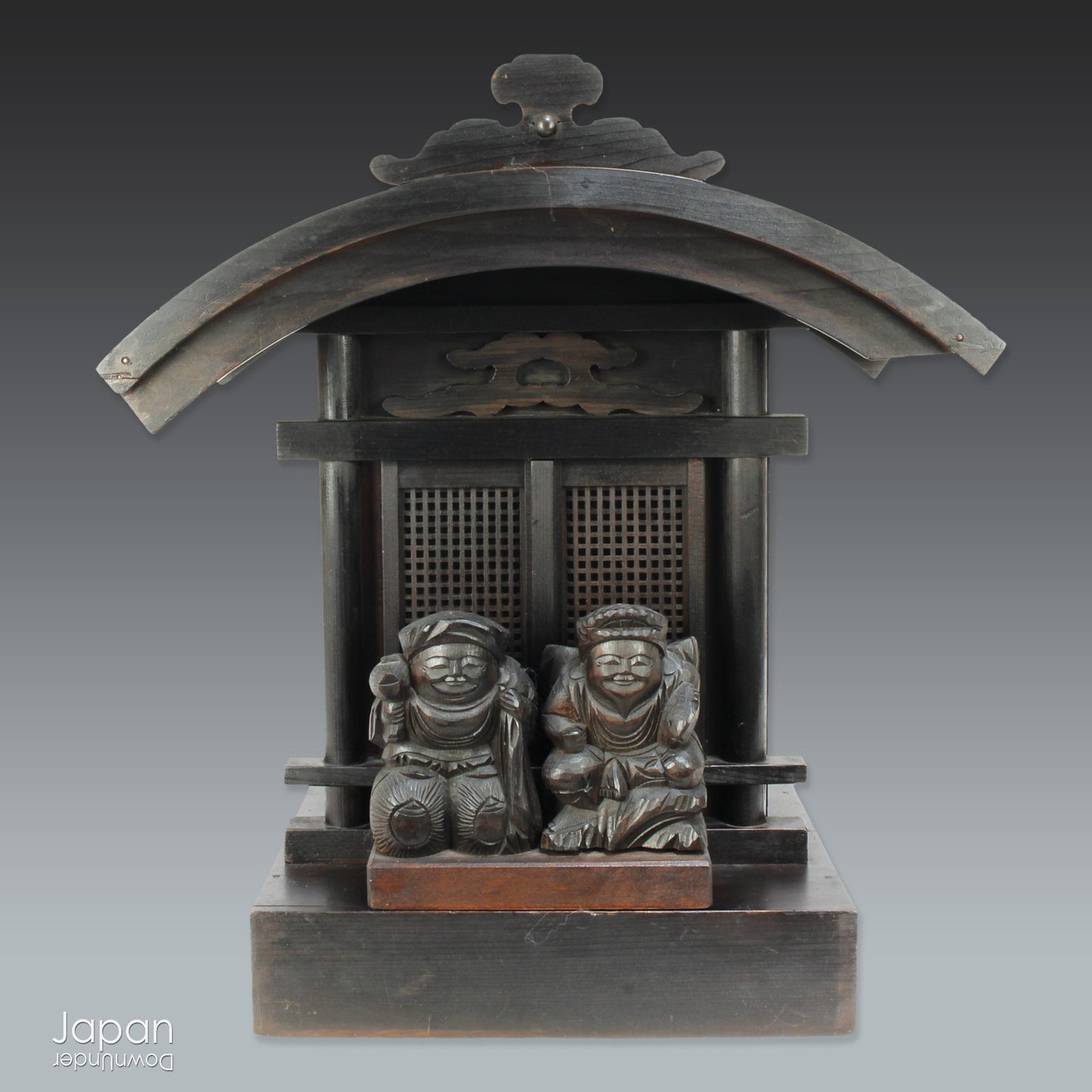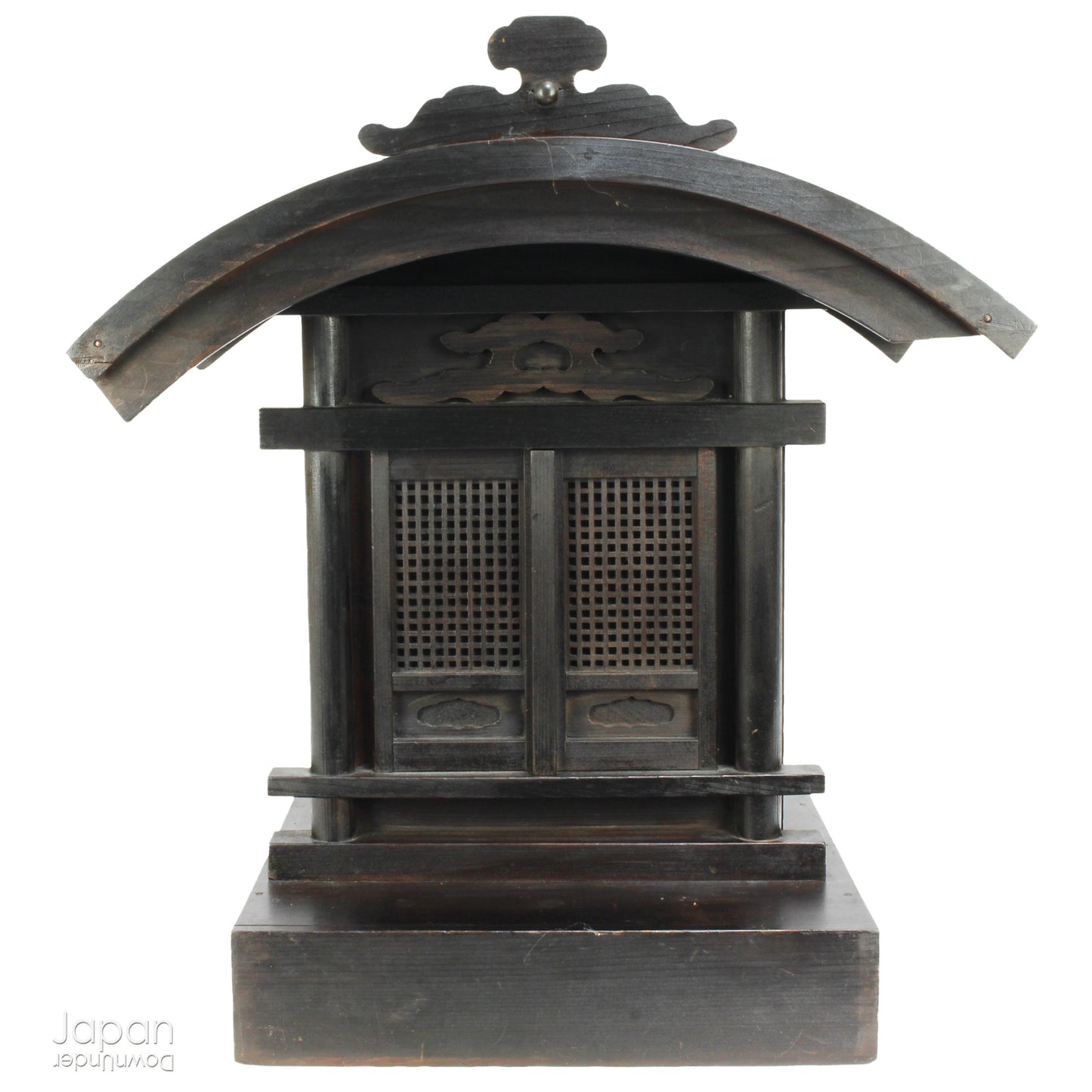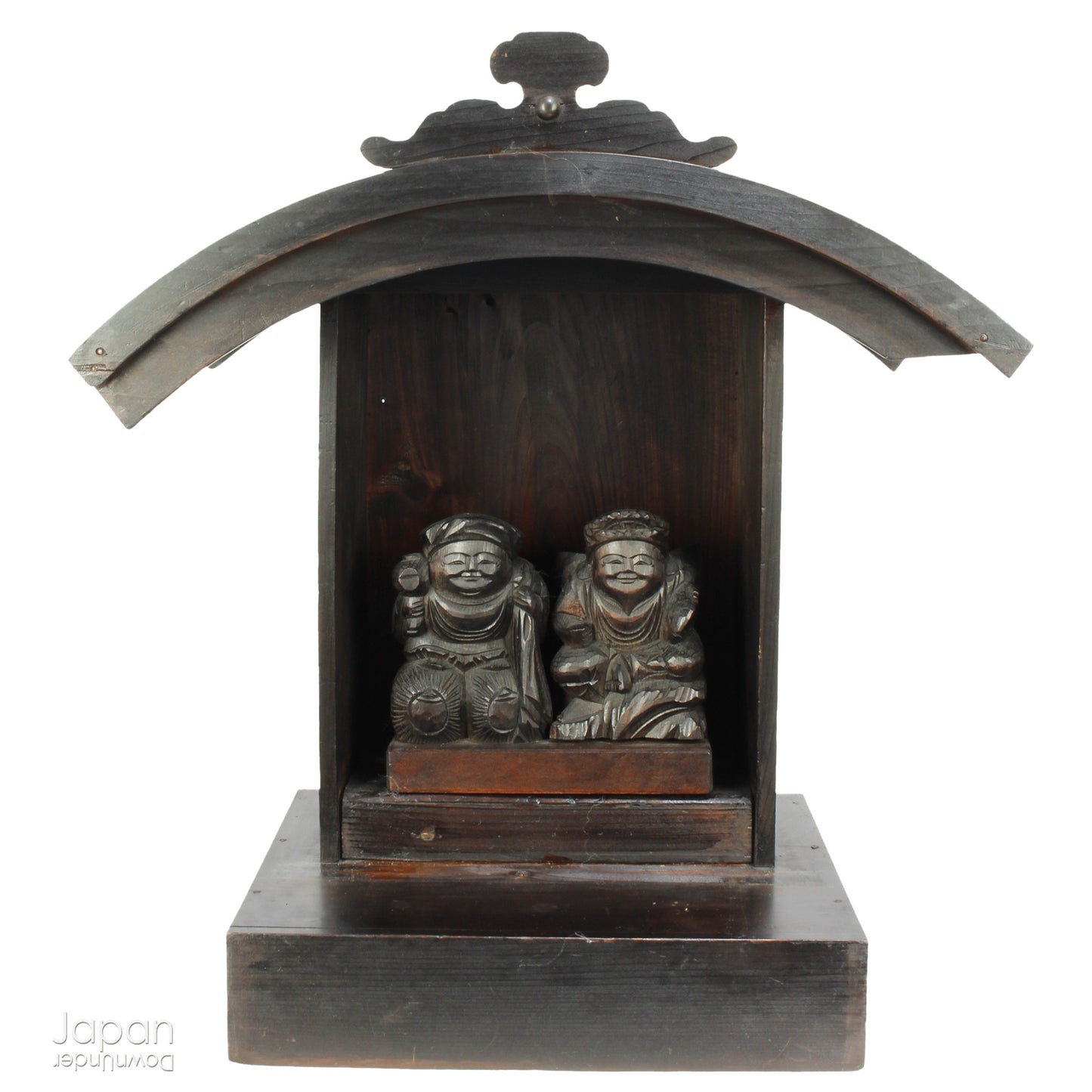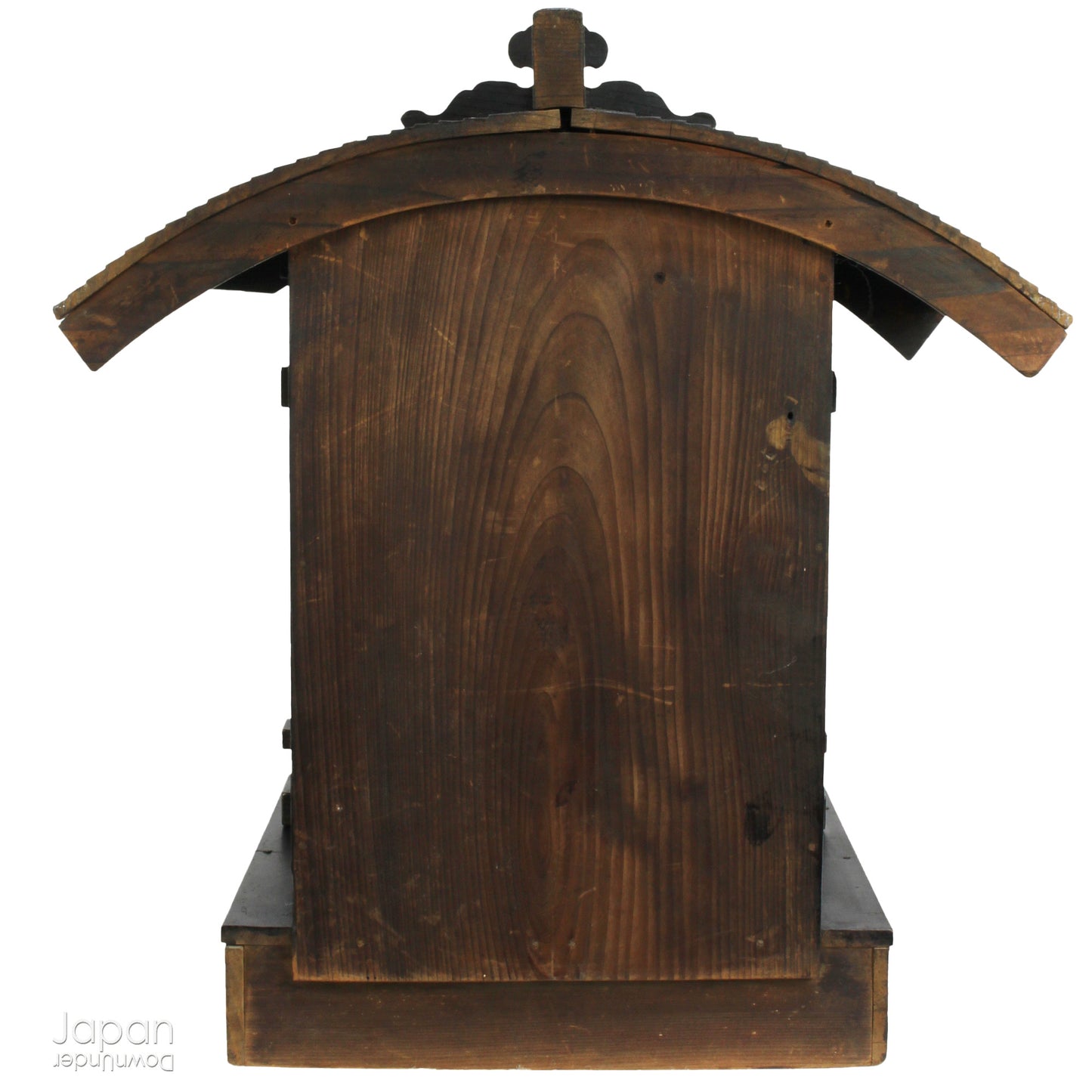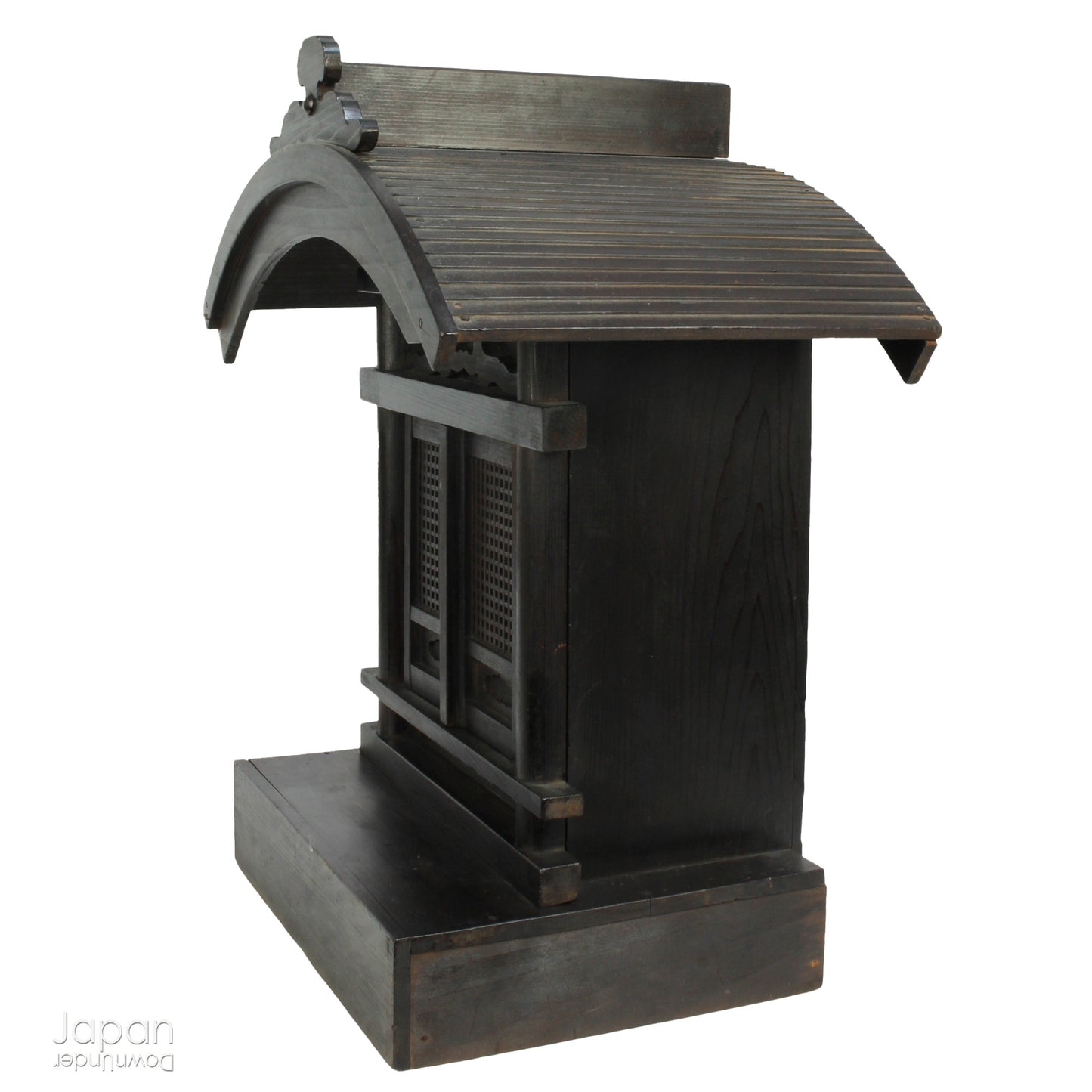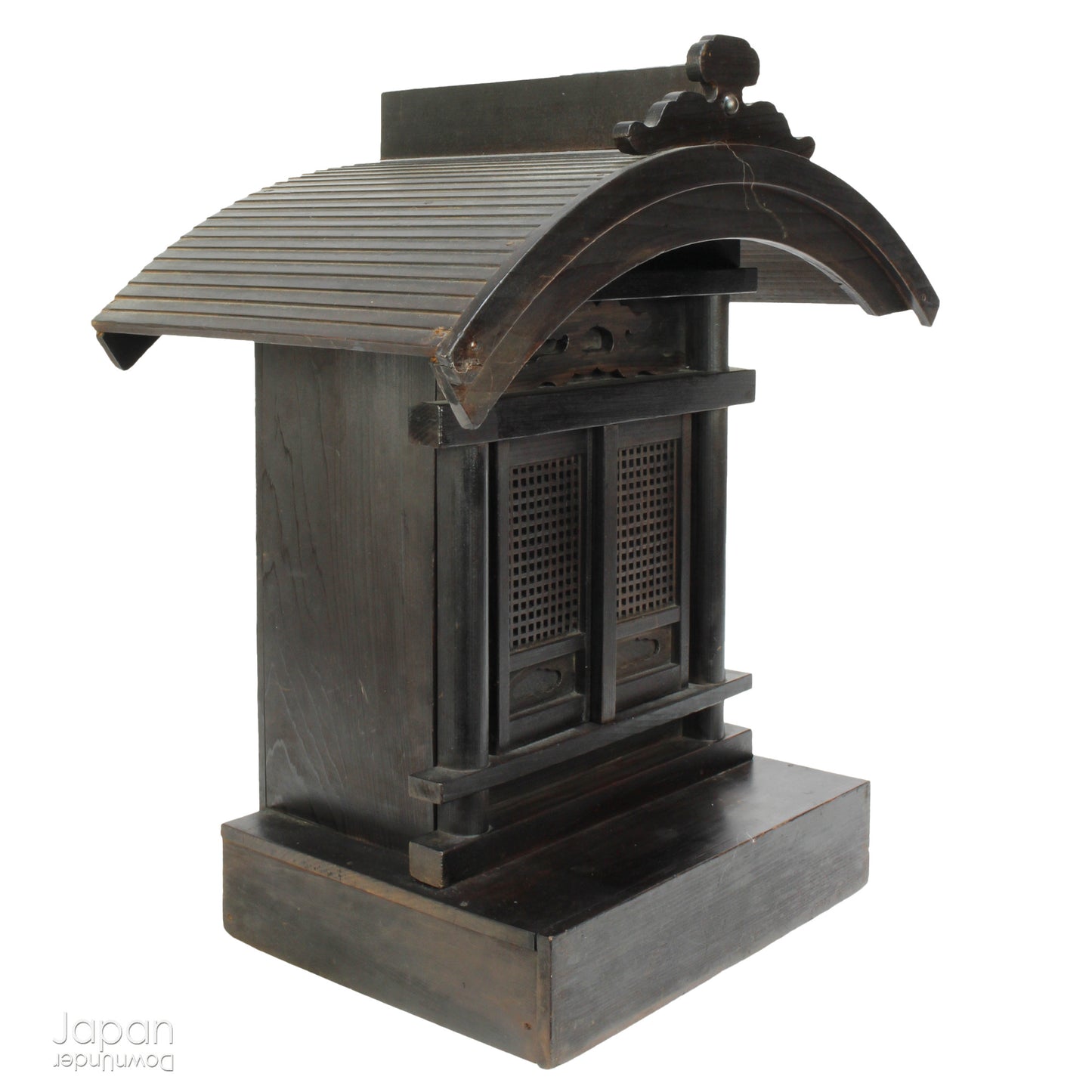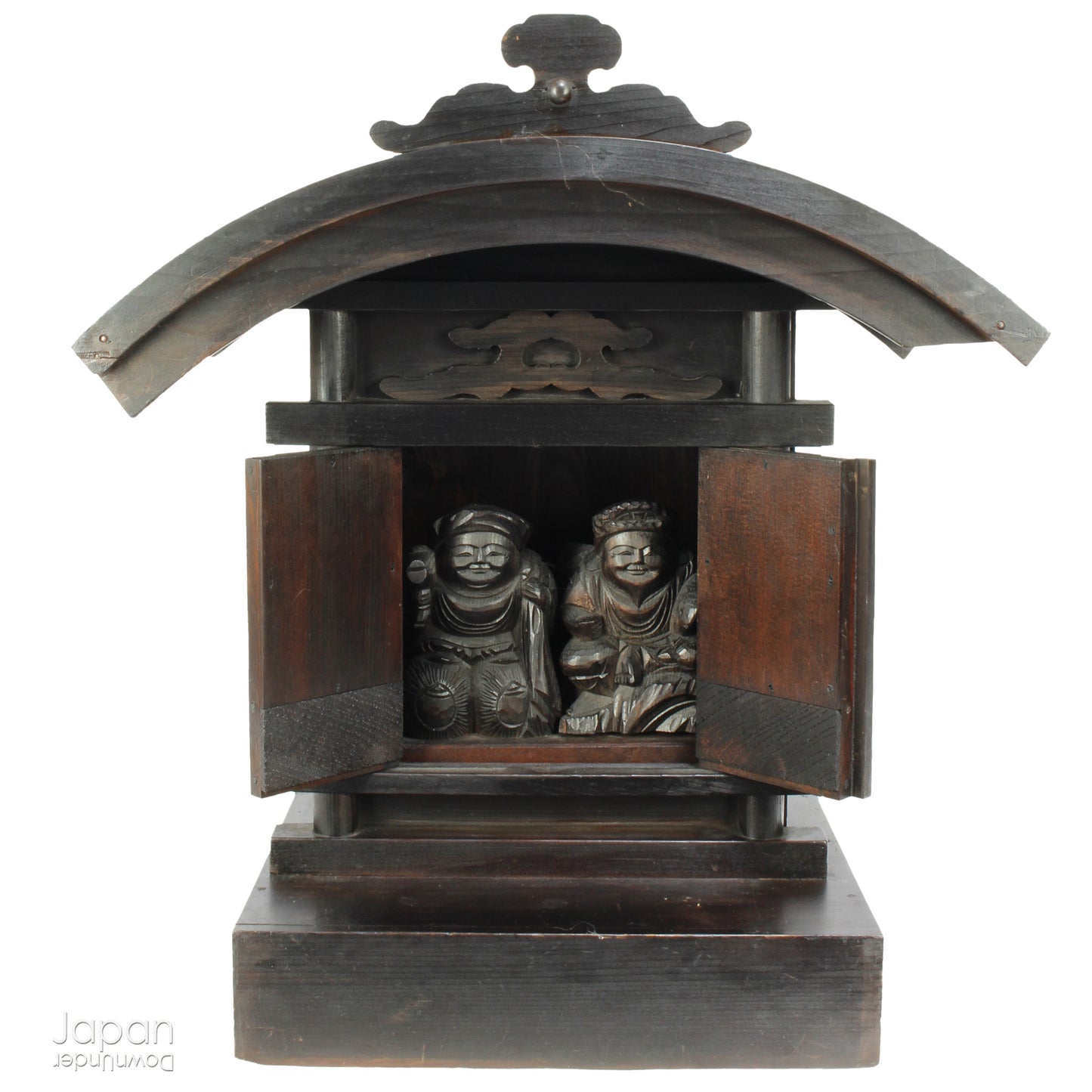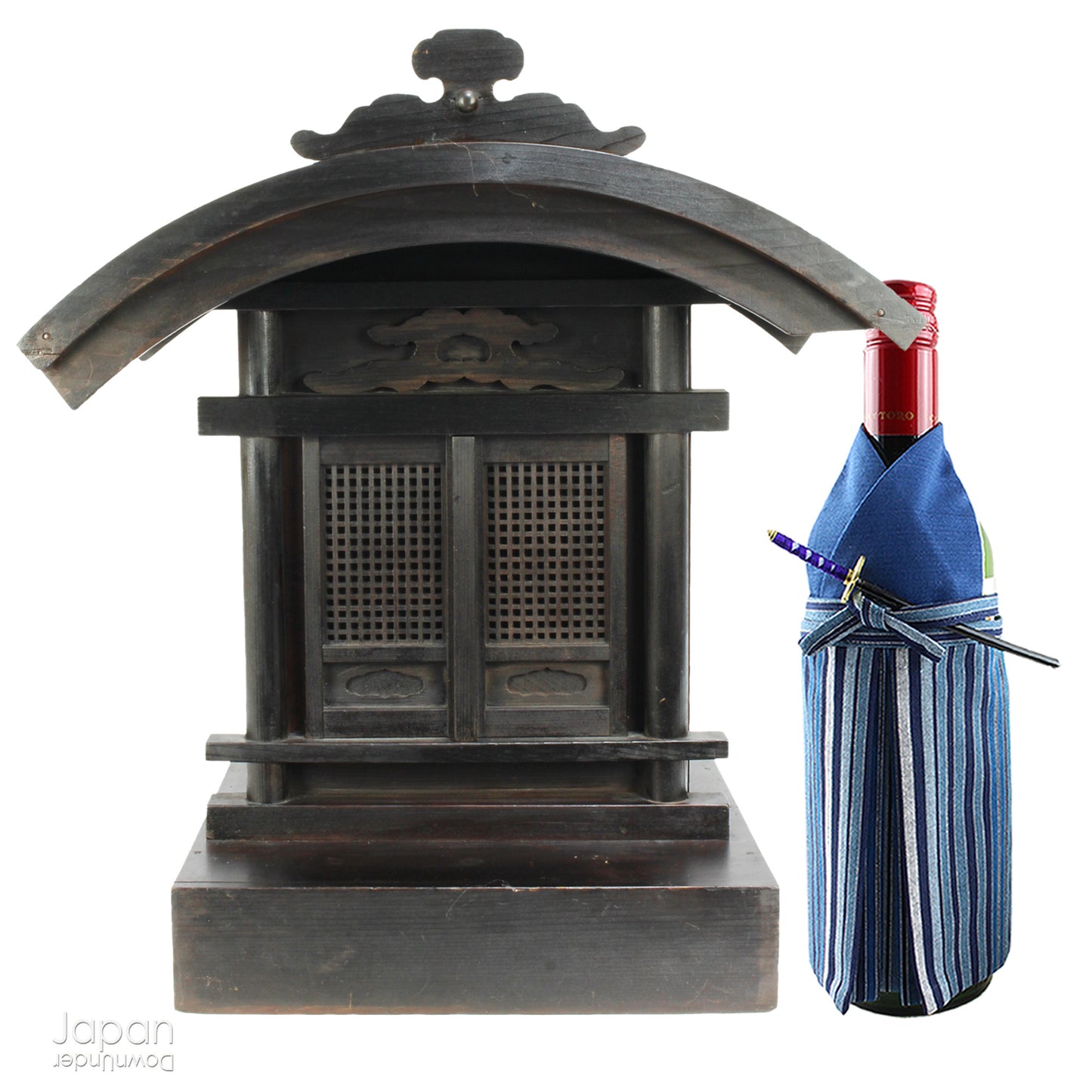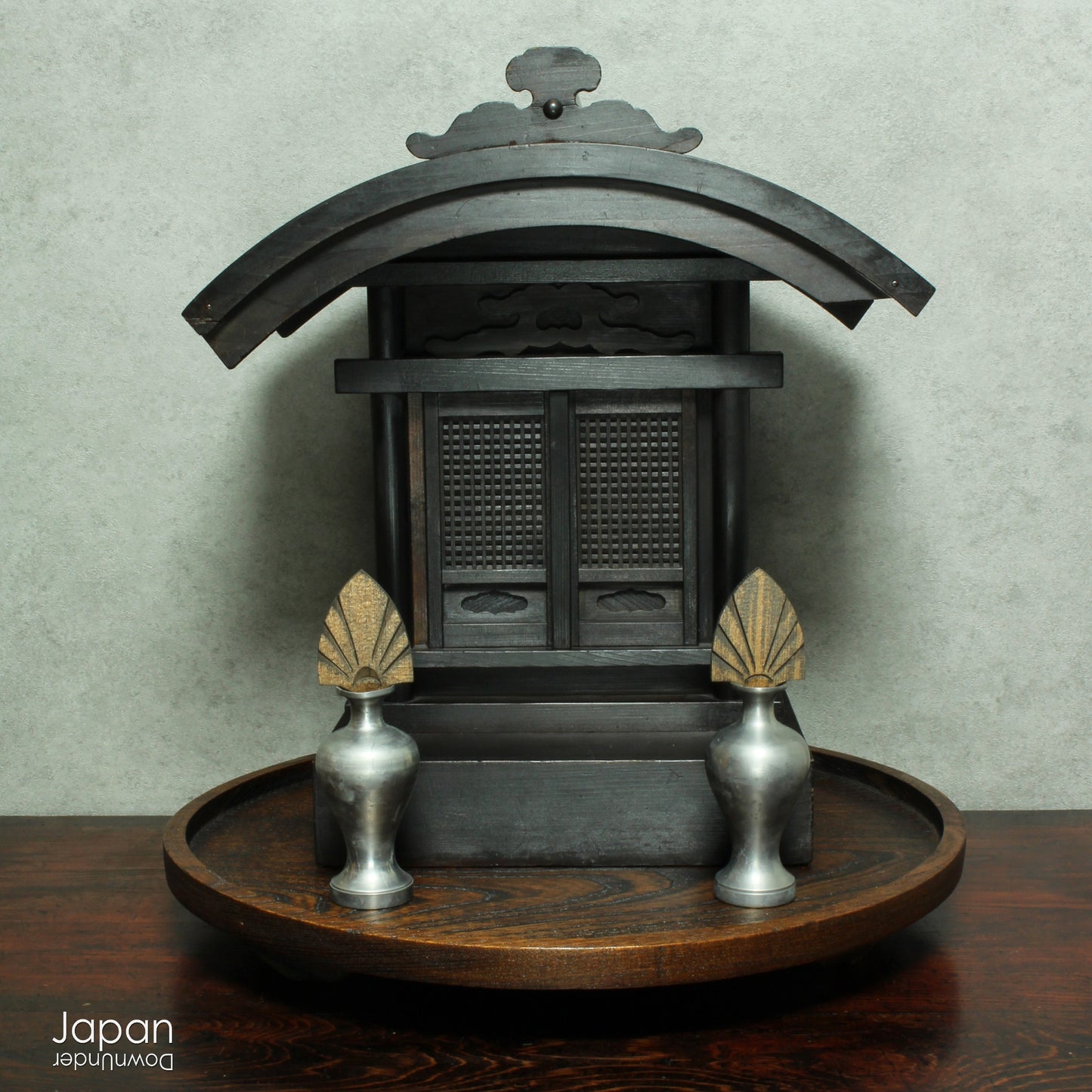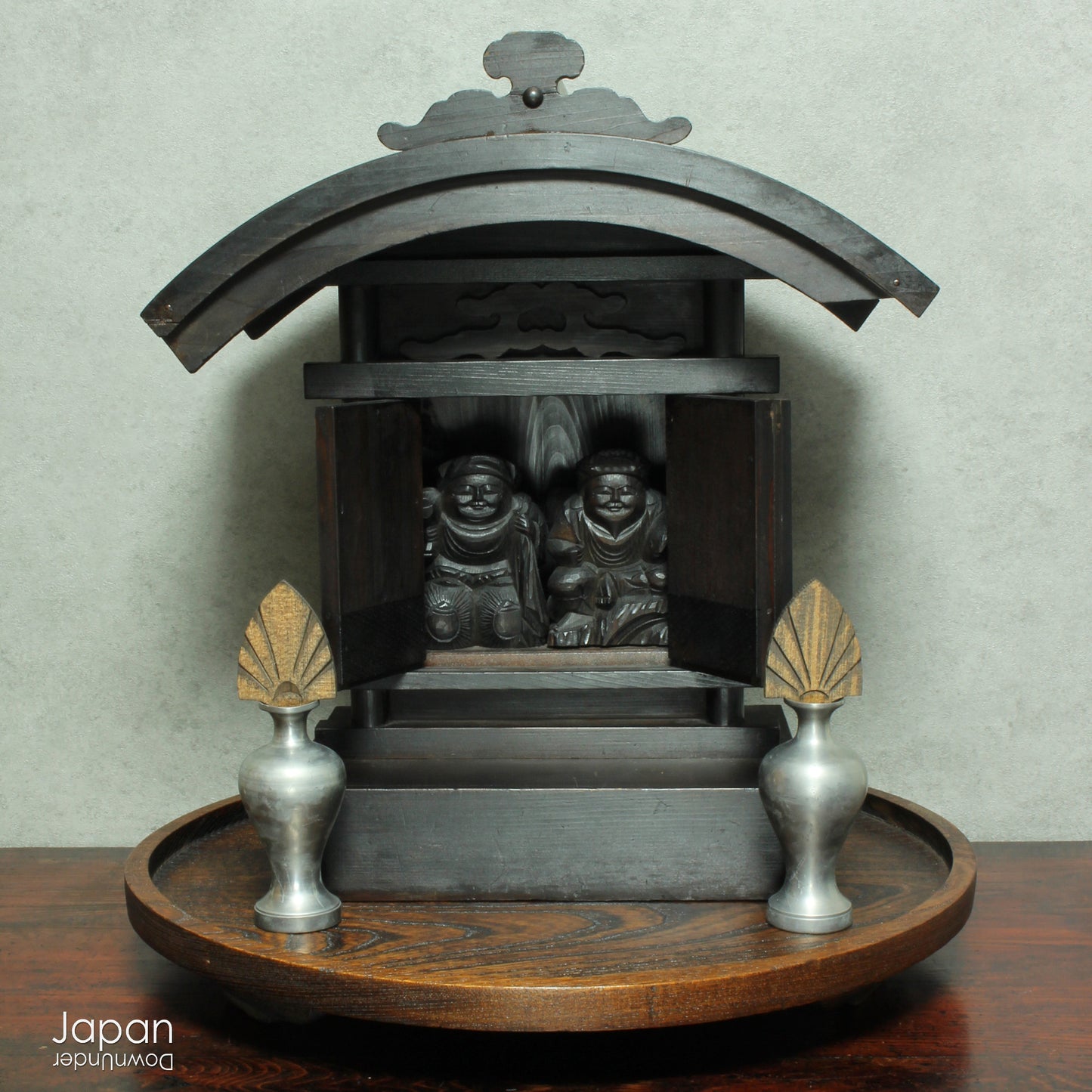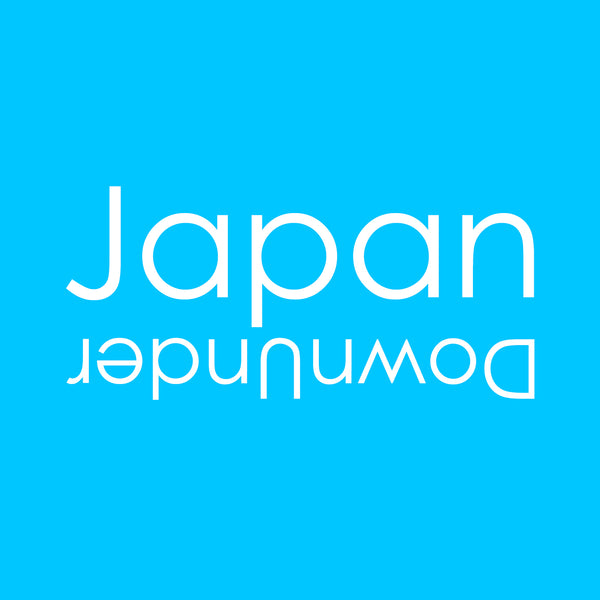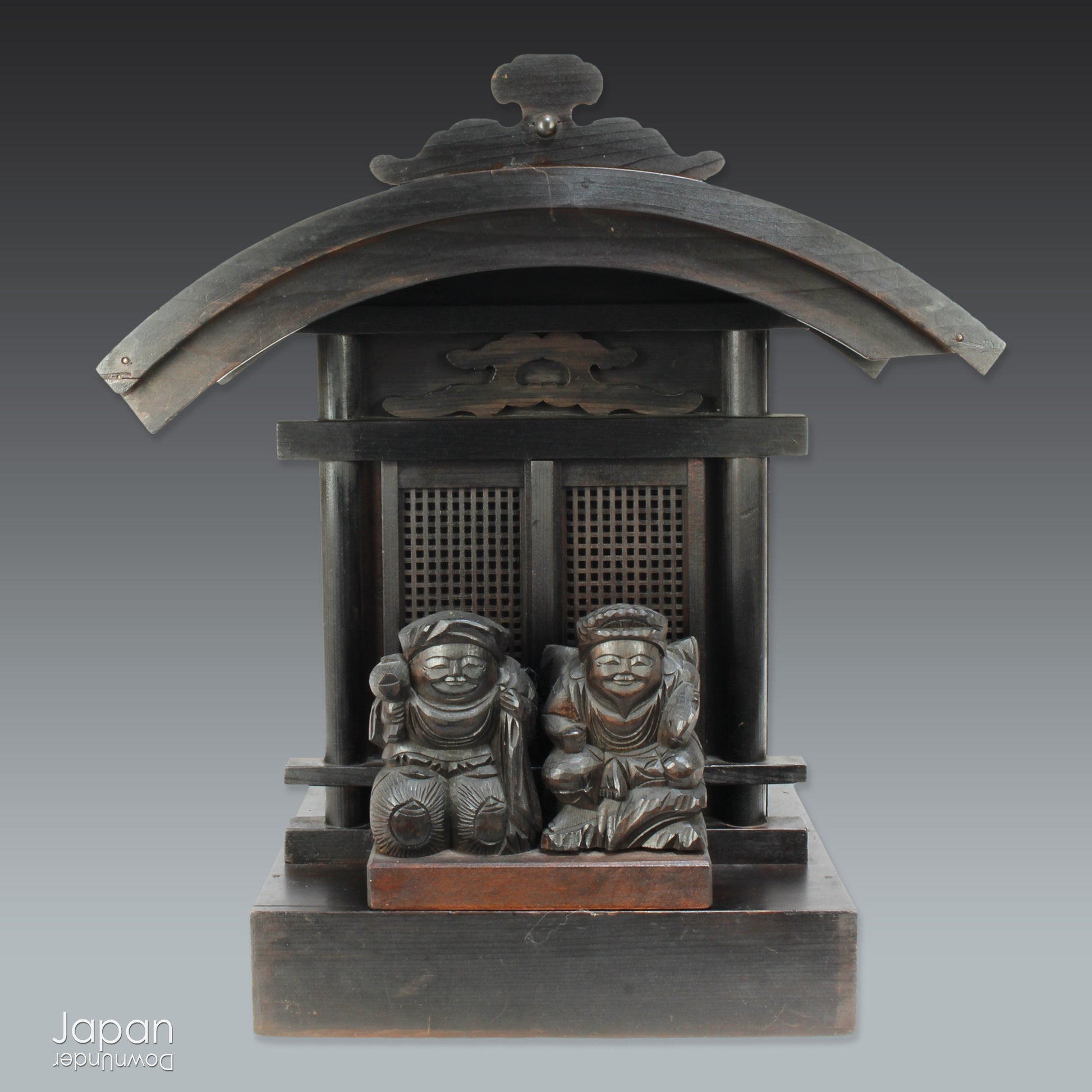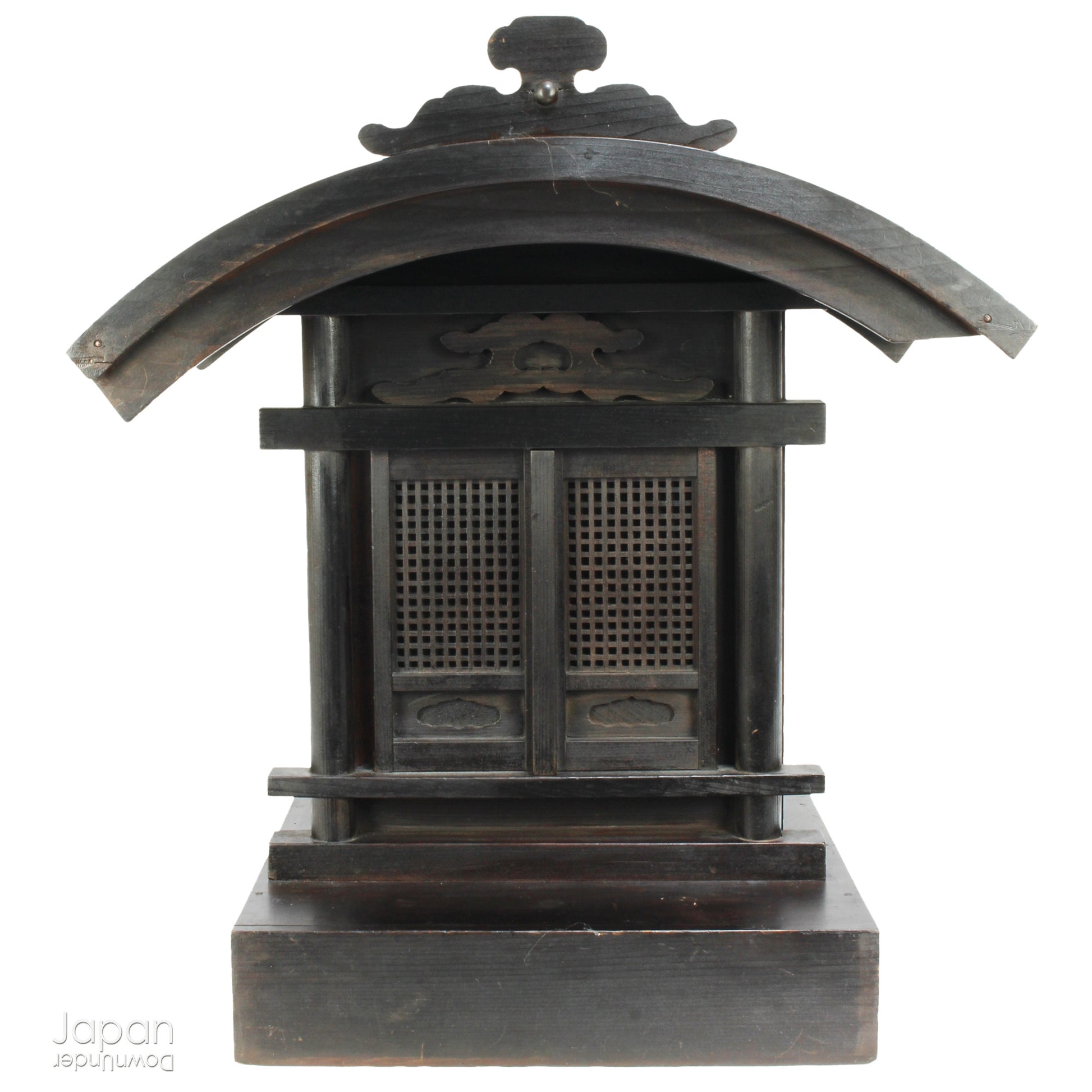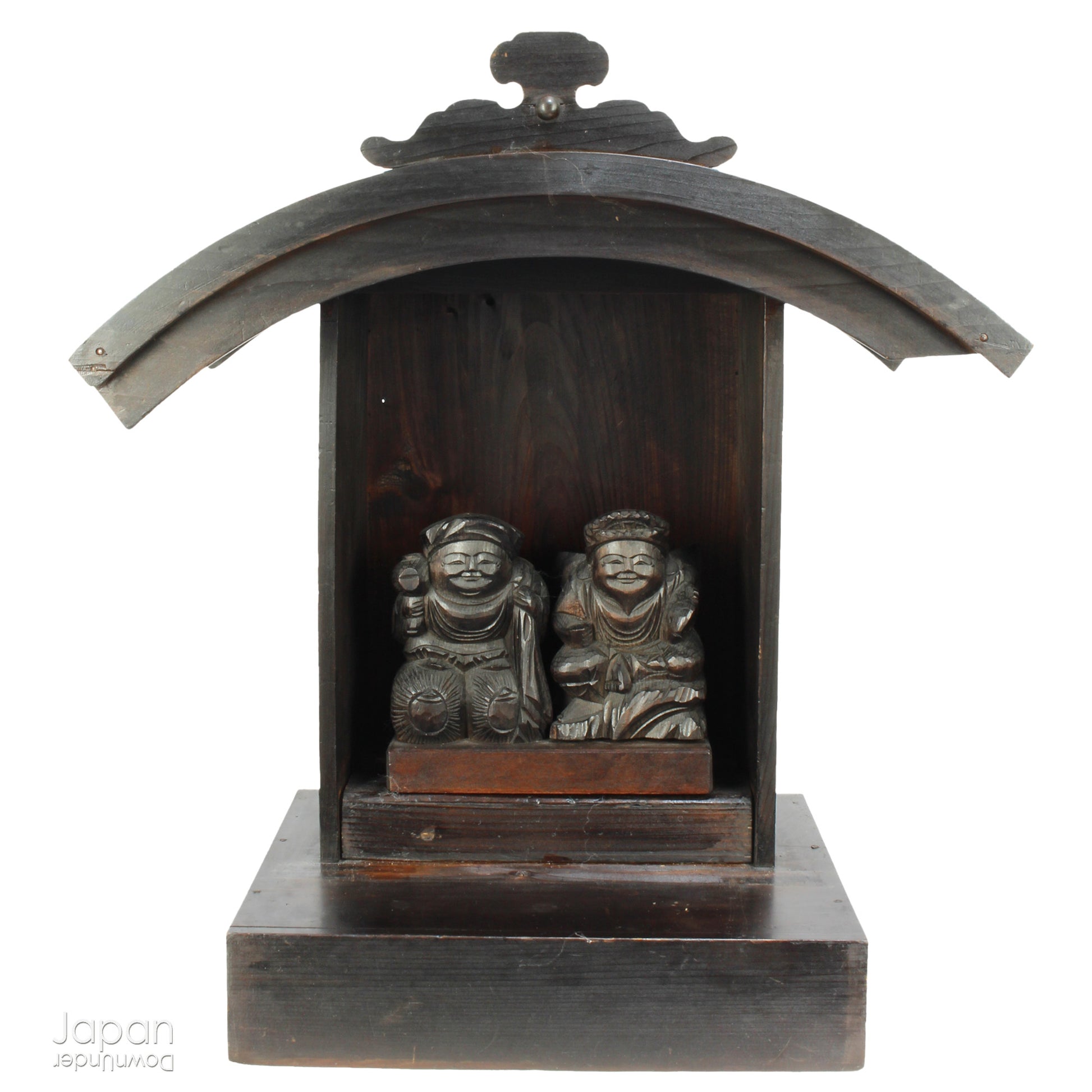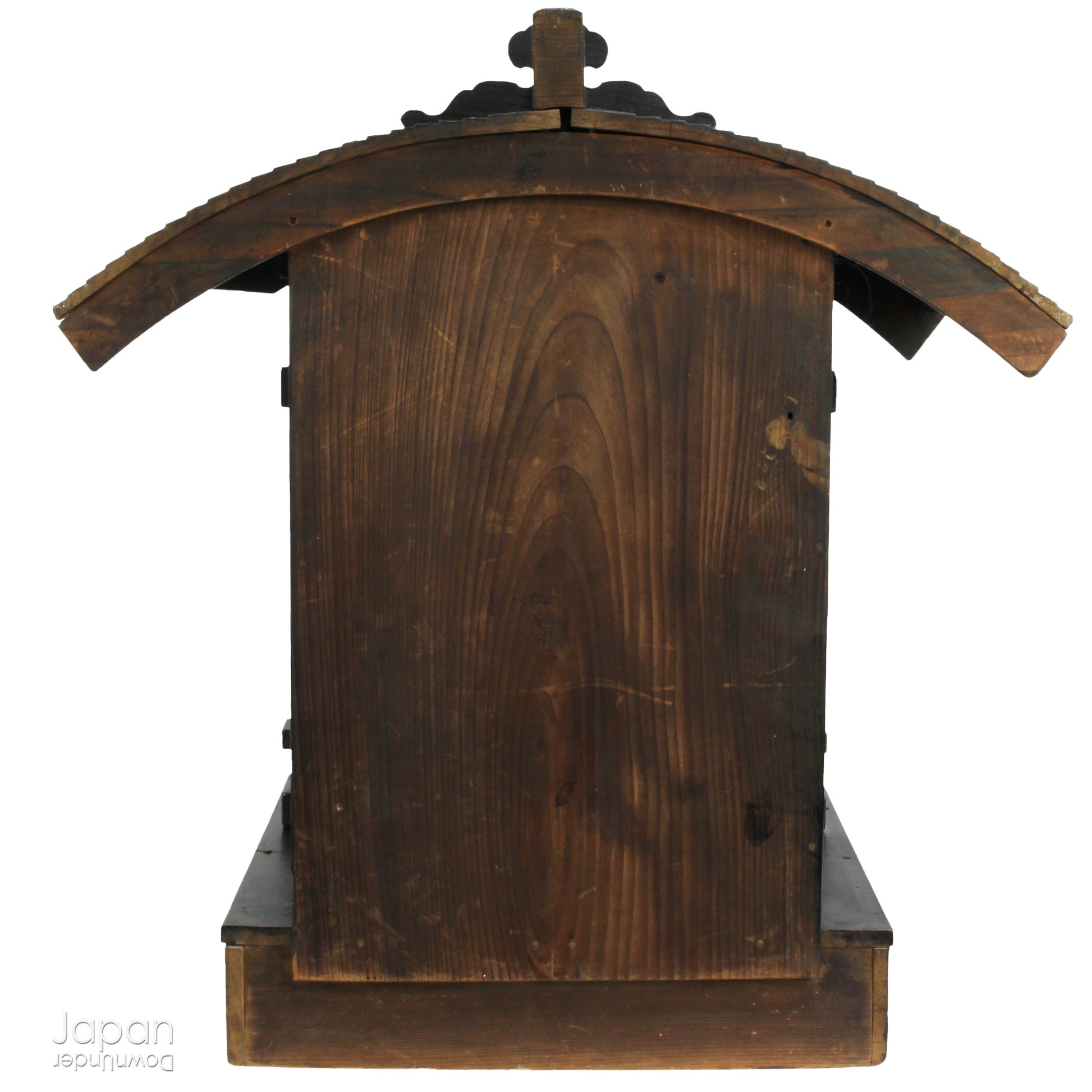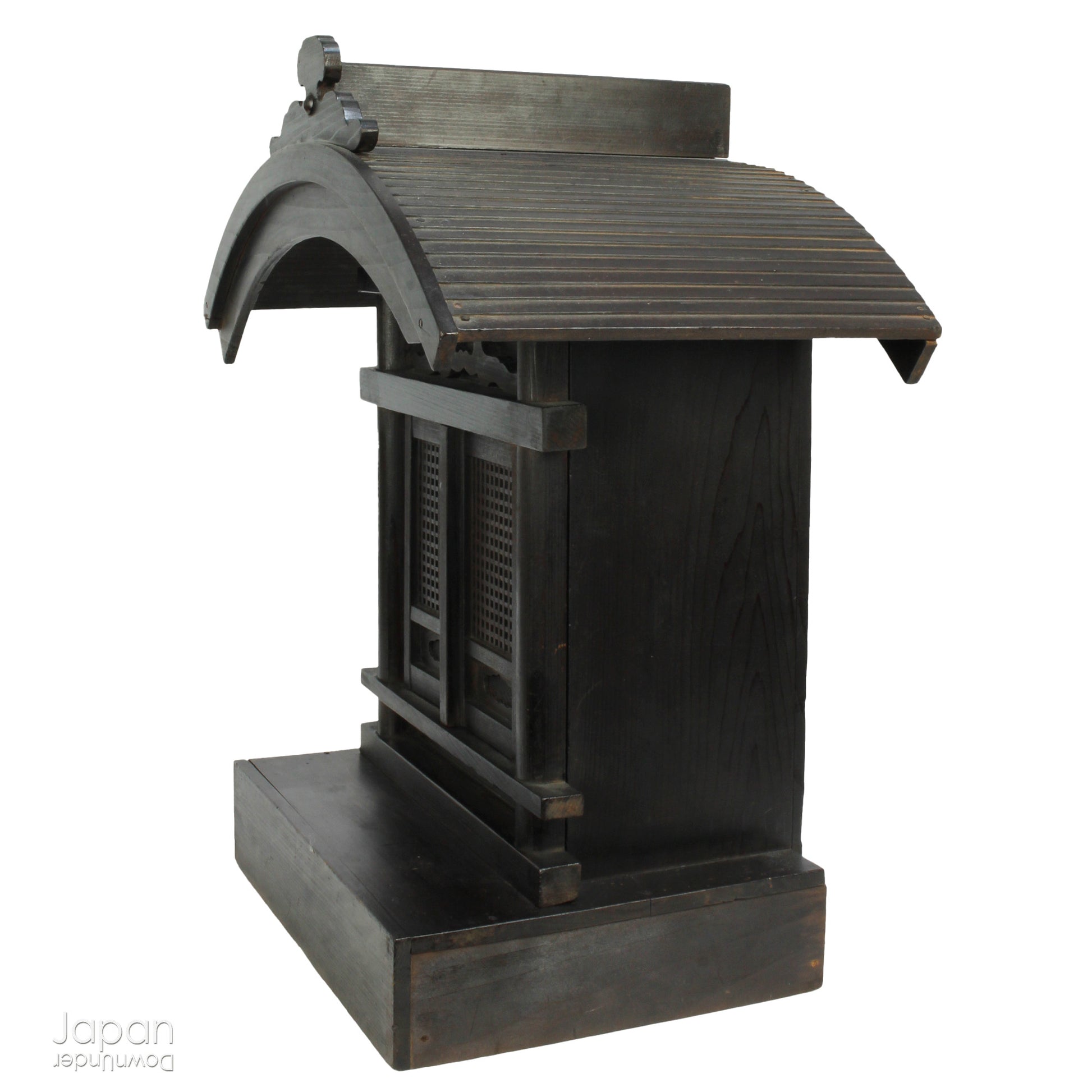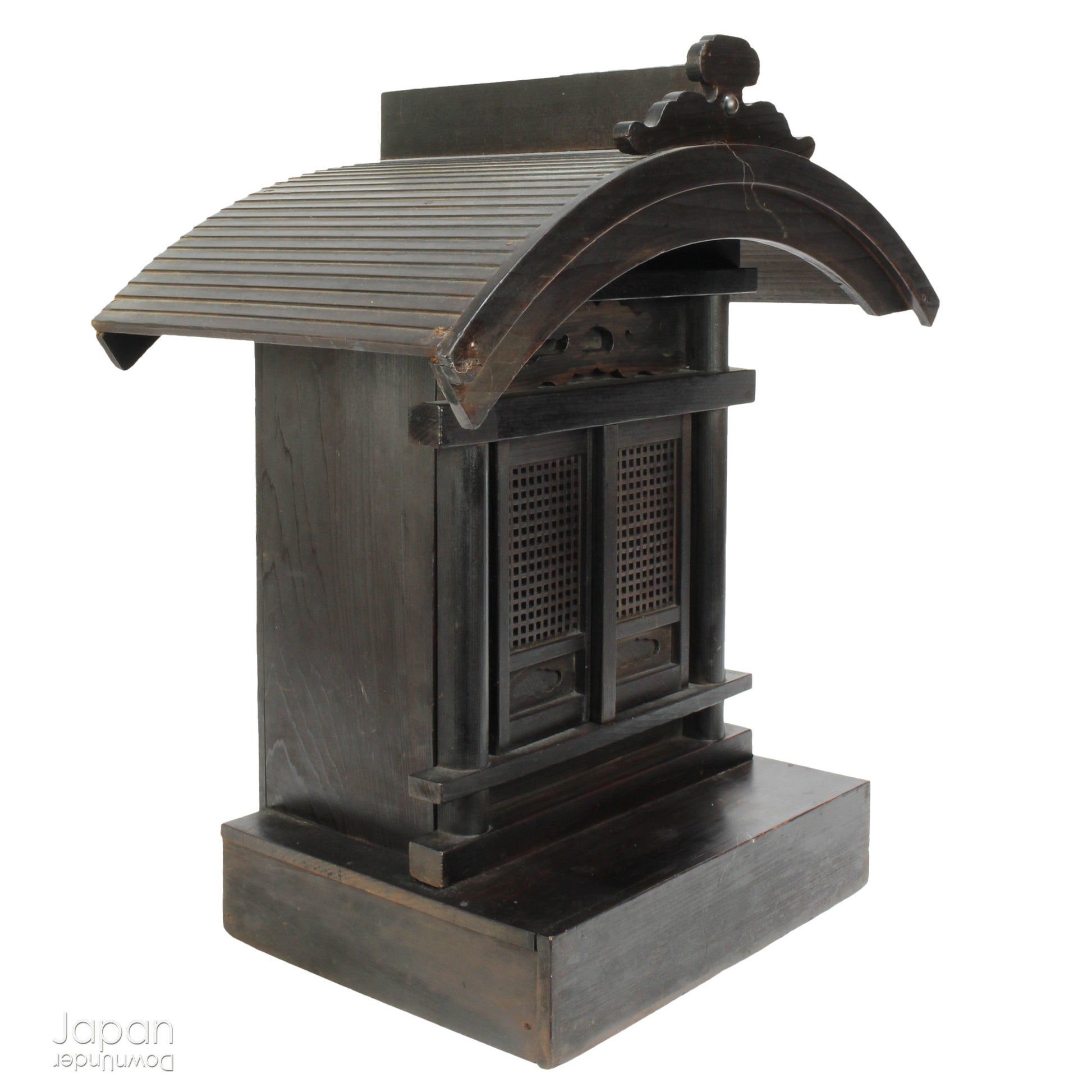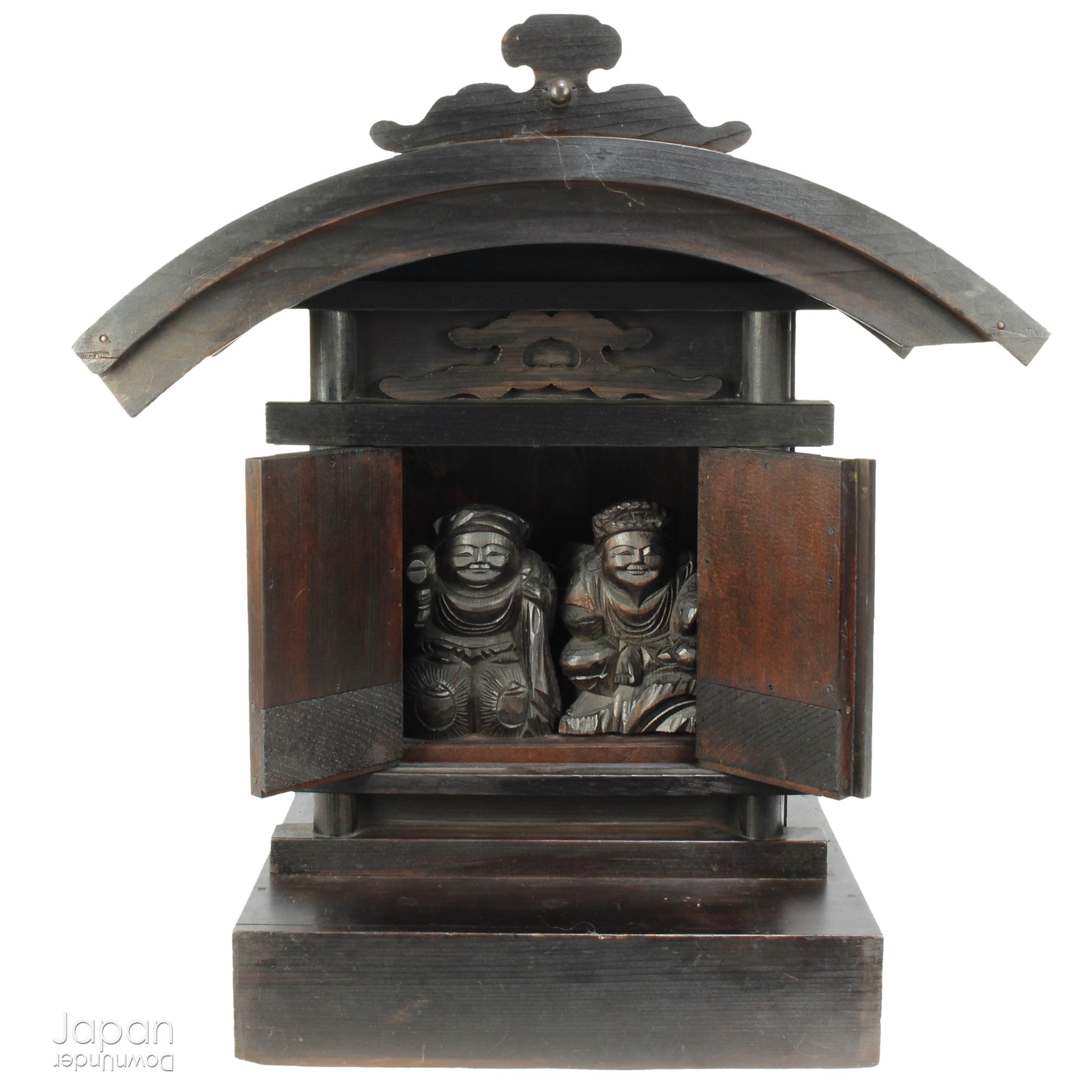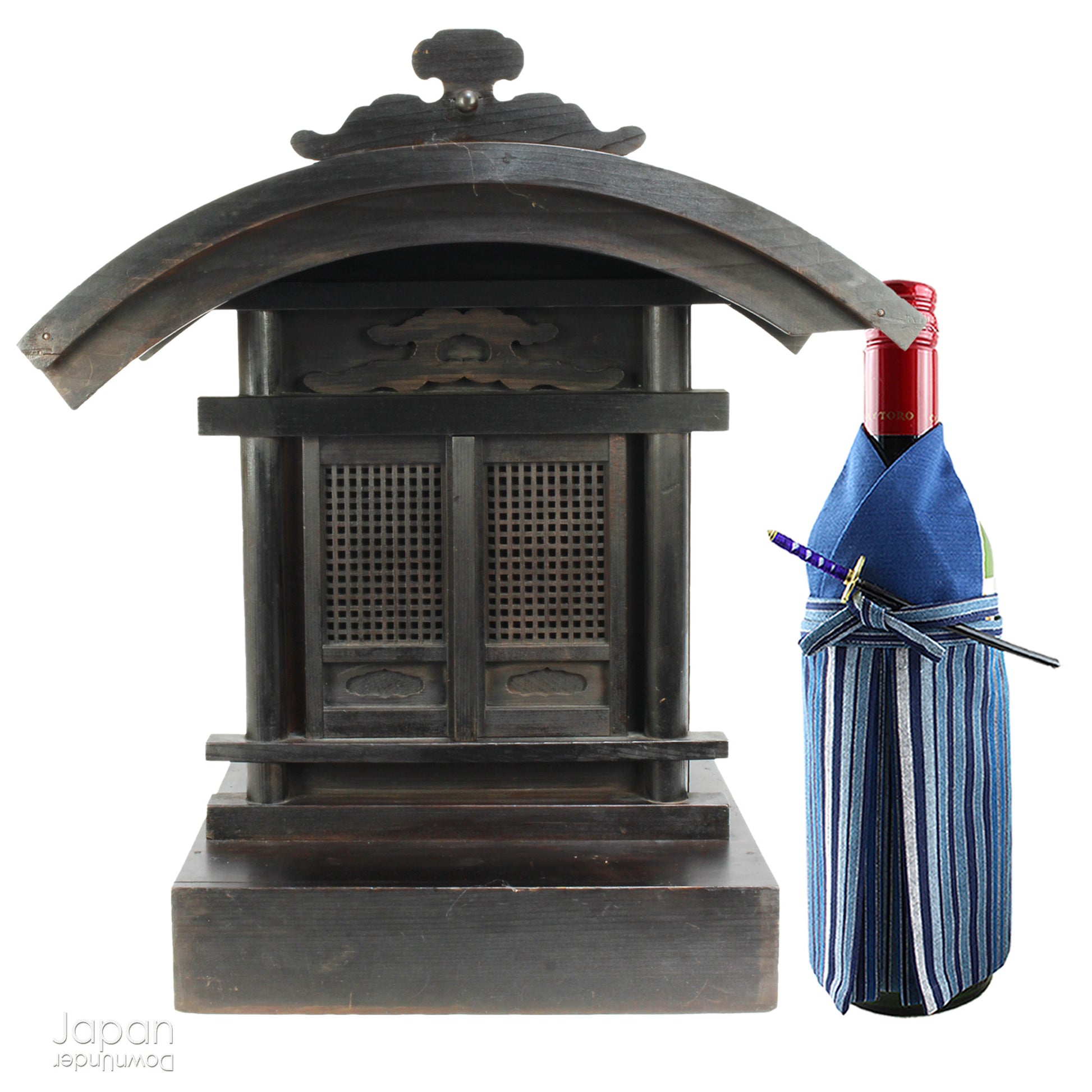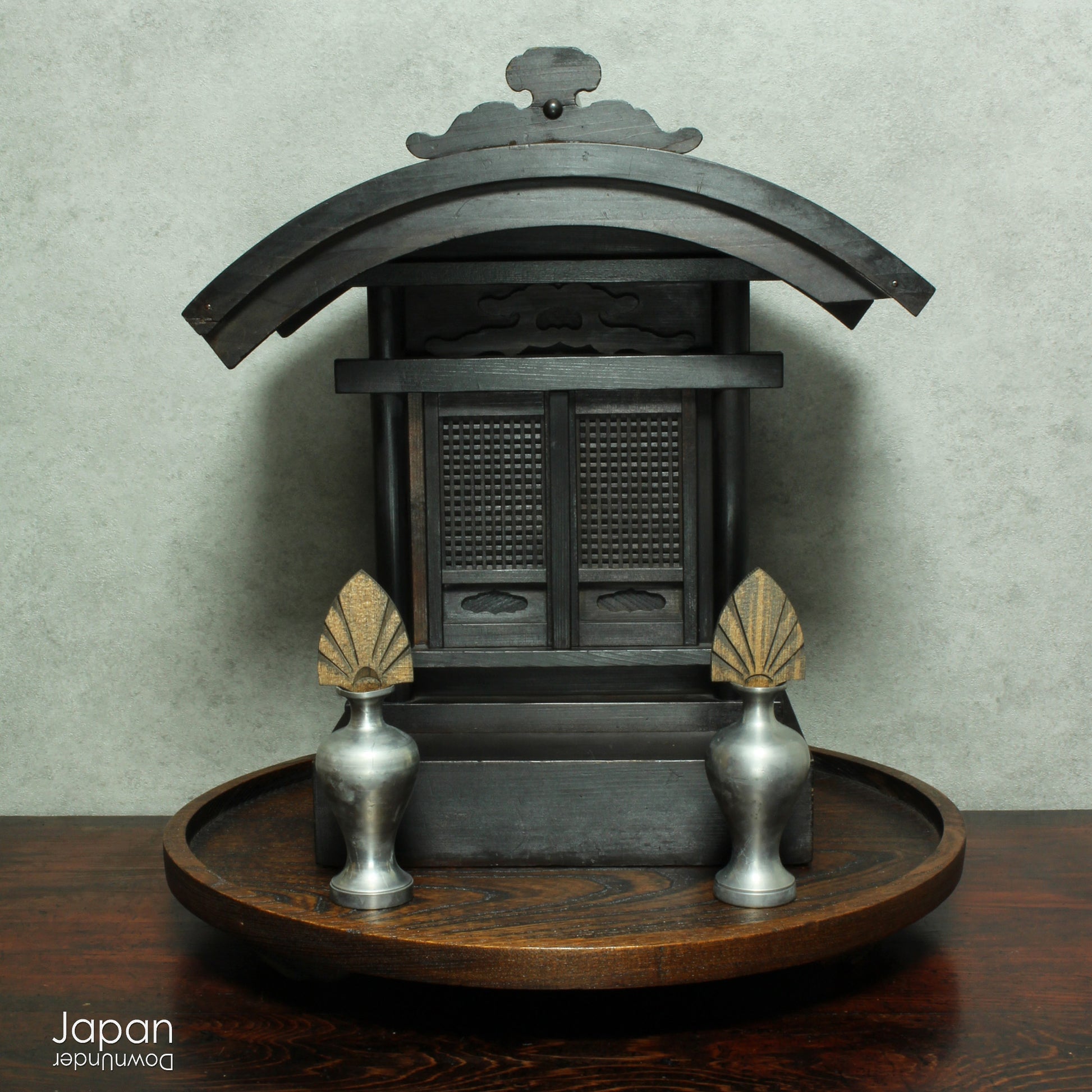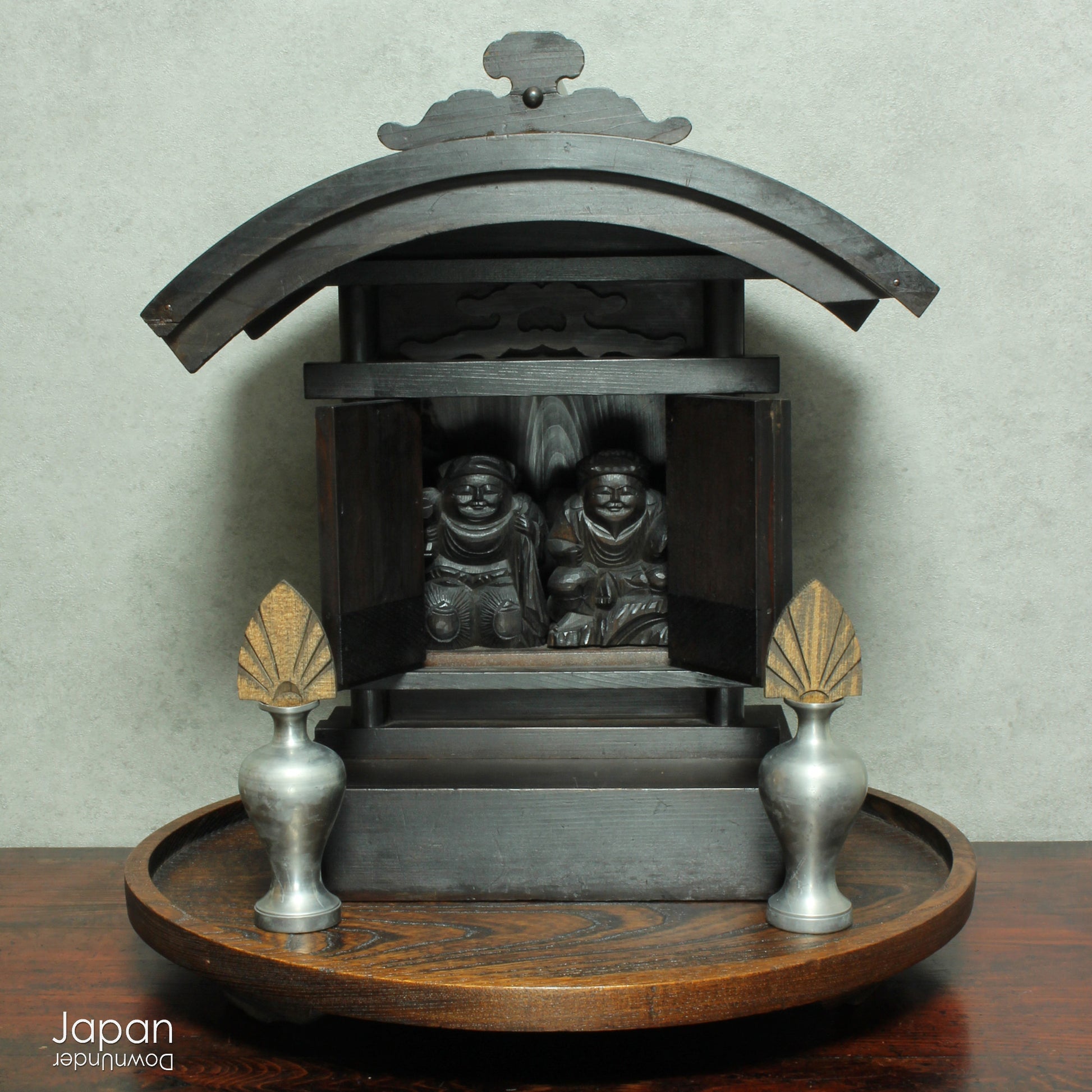JapanDownUnder
large japanese antique kamidana shinto shrine with ebisu and daikoku - spiritual folk art
large japanese antique kamidana shinto shrine with ebisu and daikoku - spiritual folk art
Couldn't load pickup availability
Love Japanese Style Like We Do
Experience the profound spirituality and artistry of Japan with this authentic Shinto folk faith shrine, dating back to the early 1900s. Perfectly suited for your own kamidana (god shelf) or as a sacred focal point within your home, this exquisite antique shrine honors the beloved lucky gods Ebisu and Daikoku - symbols of prosperity, good fortune, and well-being.
At the heart of every kamidana was a kamifuda - an enshrined sacred paper representing a deity, often received from a national Shinto shrine - placed for daily worship. In rural homes, where fishing, farming, and craftsmanship sustained life, families often placed shrines with additional gods. Their blessings were sought for abundant harvests, bountiful catches, and household happiness. In fact, some homes featured two kamidana: a regular shrine shelf and an engidana - a special shelf dedicated to these fortunate deities. Daily offerings, prayers, and candlelight rituals were central to this cherished practice.
Crafted from light, fragrant Japanese hinoki (cypress) wood, this larger-than-average kamidana showcases a distinctive rounded roof - a style unique to Ebisu and Daikoku shrines. The front panel that slides upward from the base has two intricately designed shoji lattice doors, accented with delicate wooden embellishments both above and below. Atop the roof, a finely carved cloud motif symbolizes the shrine’s connection to heaven and the divine.
The statues of Ebisu and Daikoku are nice examples of ittobori woodcarving - handcrafted with a single chisel from a solid block of wood. You can appreciate the sharp, angular chisel marks and the rich darkening of the wood with age. Each figure boasts finely detailed facial expressions: Ebisu wears a traditional peaked hat, holding his iconic fishing rod and a large snapper - Japan’s symbol of good luck - while the cheerful, plump Daikoku stands confidently on bales of rice, carrying a magic mallet and a bag overflowing with gold coins. Both figures are mounted on small wooden stands, perfectly elevated for display when the shrine doors open.
This charming shrine has been lovingly preserved for over a century and remains in good vintage condition, with only minor signs of wear reflecting its authentic history. A small wooden piece beneath the rounded roof on the right side is missing, and one god has detached from its stand, but both statues are free of cracks and retain their intricate detail.
A beautiful fusion of mingei folk art and spiritual tradition, this unique Shinto kamidana will bring a meaningful, elegant touch to your decor - invoking blessings of fortune and serenity for generations to come.
- measures around 39.5 cm (15.6”) tall x 36 cm (14.2”) across x 19 cm (7.5”) deep.
- gods on stand measure 12 cm (4.7”) tall.
- weighs 1,700 gm.
(listing for god house with two gods only)
SHIPPING INFORMATION
- please read our shipping notes in shipping policy.
- we use recycle packaging and wrap for safety, rather than appearance.
ABOUT OUR VINTAGE, ANTIQUE AND OTHER ITEMS
We list pieces we feel are worthy of display. There may be scratches, dents, fading and signs of wear and tear. We try to explain the condition of each item exactly, but may miss something.
Information regarding the item and it’s age is obtained from dealers and our personal research. We do our best to give you the correct information but please be aware that we cannot guarantee this information.
Please message us prior to purchase with any questions you may have about our products.
KAMIDANA
Kamidana, literally god (kami) shelf (dana) are miniature household altars used to place an enshrined Shinto kami (god). The enshrined kamifuda (board or paper, representing the god) was that of a clan deity or came from one of the major national shrines. Kamidana became popular in traditional country style minka houses.
Small shrines for tutelary deities, inside a residence, go back to ancient times among the aristocracy. The emergence of the kamidana was closely connected with the development of the domestic Buddhist altar or butsudan, which started the movement of conducting religious rituals in each household.
Kamidana were initially set up to keep Jingu Onusa, charms of the Grand Shrine of Ise, when they began to be widely distributed at the end of the Muromachi period. The Jingu Onusa symbolized Amaterasu Omikami and were considered objects of worship. A special domestic shelf, to respect these charms, was installed and was called Jingu no tana, or shelf of the Grand Shrine. By the mid-Edo era, the institution of the kamidana had spread to most homes as a result of the spread of this Ise cult.
The most common style of kamidana was a plain board forming a shelf, supported by cantilevered brackets from beneath, or stabilized with timber hangers, suspended from the beams above. On this shelf a miniature Shinto shrine was installed to contain the kamifuda. This shrine could be elaborate in design, but unlike the miniature shrine cabinet, or zushi, of the Buddhist altar, the timber was unlacquered. In days gone by, shrines for the kamidana were very expensive for common country people and they were often hand made, by the owner, giving them a lovely rough, simple and rustic appeal.
Kamidana were most often located in a high place, thought to be closest to the heavens and gods, in an area close to an earth floor. As old country kitchens had an earth floor and were a place where many people gathered, they were perfect for the kamidana and prayer. Candles were lit and offerings of rice, fruit, fish, rice and wine were made daily.
Particularly in the homes of farmers, fishermen, merchants and other craftsmen, additional deities with combined Shinto and Buddhist identities found their way to the kamidana. Ebisu and Daikoku-dana were popular. Ebisu, the god of fishing and Daikoku, the god of farming, were particular favorites amongst country folk, whose livelihood depended on agriculture and the ocean. Ebisu and Daikoku were often housed together in a special shrine with a rounded roof, and came to be known as the kitchen gods. Kojin-dana was another popular choice. Kojin was the god of domestic tranquility and good fortune. Inari-dana were also seen. Inari is the Japanese Shinto god who watches over and protects the rice harvest. A temporary toshitoku-dana was set up in almost all homes at the end of the year to welcome and worship the kami of the New Year.
Old Kamidana shrines are a wonderful example of Japanese mingei; a spiritual tool that reminds us of culture and customs of the past.
KITCHEN GODS - EBISU AND DAIKOKU
Ebisu and Daikoku are known as the lucky kitchen gods. They were placed on a shelf high up in the kitchen and given daily offerings to bring good fortune into the home.
Ebisu is known as the God of commerce and prosperity, the ocean and fishing. He is the guardian of all occupations. He holds a fishing rod in one hand and a big snapper under the other arm. A red snapper is eaten at all happy events in Japan. Ebisu will make sure you always have plenty of money, success and food.
Daikoku is the God of wealth and good fortune, and of farmers and food. He is a cheerful, chubby God, standing on bales of rice. He has a sack of treasure slung over one shoulder and a magic mallet, that fulfills all wishes, in the other hand. Put him in your home and you will always have good fortune, money and lots of food.
UCHIDE NO KOZUCHI (MAGIC MALLET)
According to legend, the ‘Uchide no Kozuchi’ is a magic hammer that can grant someone anything they wish for when struck on the ground. When shaken coins will also magically fall out of the hammer. In English, it is often called the lucky hammer or magic wishing hammer. It is believed that the hammer contains a wish fulfilling jewel called a ‘Houju.’ The Houju in Buddhism is said to grant wishes, bring peace, and an understanding of Dharma or Buddhism teachings.
The Uchide no Kozuchi is usually held by the deity "Daikoku" who is one of the Japanese seven lucky gods.
MINGEI
Mingei are the tools and utensils that were used daily by the common people in Japan. They were inexpensive, simple and functional. Usually produced by hand, in large quantities, their artists were anonymous. They became representative of the local area where they were produced.
The word Mingei combines “min” meaning common people and “gei” meaning art - the art of the common people. It was coined by the Japanese philosopher Sōetsu Yanagi. He found beauty in ordinary crafts for daily use and argued that true beauty could be found only in the objects made by unknown people, in a spirit of selfless innocence and in close harmony with nature.
Share
